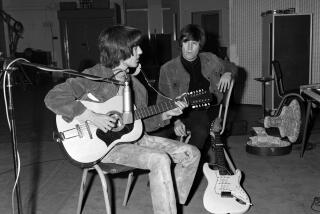Space Repairs of the Hubble Telescope
- Share via
The pictures from space of the repair of the Hubble telescope are mind-boggling! These images from CNN are living history, and should give Americans the sense of enthusiasm they felt when the U.S. first landed men on the moon in 1969. It seems we have become blase and jaded. We lose perspective on our nation’s advancements in our daily focus on the latest murder, rape or scandal. We watch TV news and events real-time, worldwide (and space-wide) without appreciating the communication satellites that make it all possible. Some people still ask “Why should we have a space program?” Communication is the most visible, but not necessarily the most vital, of all the benefits we have derived from space activity.
SHIRLEY THOMAS, Professor, USC. The writer is author of “Men of Space,” Vols. 1-8 .
*
No doubt the NASA government contracting process requires revamping to assure on-time, per-contract performance of commitments. We hear of vendors receiving what amounts to unchecked dollar and time extensions at taxpayer expense--only to result in hardware or software that doesn’t perform to specification.
In “Obscure Firm Took Task to Focus Hubble” (Dec. 8), we finally hear about a company that was willing to step in and take on a daunting optics manufacturing project badly needed by NASA after all the “regulars” declined. Tinsley Laboratories used its creativity in grinding mirrors to “billionths-of-an-inch” tolerances for correcting faulty Hubble space telescope optics. They exceeded NASA’s above-state-of-the-art specs and time frame at a final cost almost 47% below budget.
In keeping with the spirit of private industry reward Tinsley deserves a bonus! (How about an industry-accepted half of the savings on the budget.) If we expect to encourage what is finest in our business community, we need to provide incentives--and rewards when they are due. I salute Tinsley for showing us what the “little guy” can achieve.
HOWARD I. LITTMAN, Agoura Hills
*
Astronaut Story Musgrave alluded to the song “From a Distance” to explain how there are no national boundaries when the Earth is viewed from the shuttle. Similarly, when I watch the astronauts working to repair the Hubble telescope I see no boundaries between race, gender, religion and nationality. The bulky spacesuits conceal any differences that we use to prejudge people before we actually get to know them.
In space, weightlessness is the ultimate equalizer. Instead of “mild-mannered” Clark Kent going into a phone booth to change into Superman, there’s astronaut Kathryn Thornton changing into Superwoman and picking up a piece of equipment the size of a 640-pound phone booth. Without gravity, the touted physical superiority of man over woman quickly drifts away. The superiority of the astronauts comes not from their physical strength, but from their ability to work as a team in an effort to achieve their goals. Any differences between the astronauts enhance their unity of purpose, as each brings her/his own special talents.
Each of us on Earth has unique talents, as well. “From a distance” it’s difficult to get to know people of a different gender, race, religion or nationality. Our planet needs to come closer together and work with our differences as a team to ensure the survival of future generations on Earth.
ALAN GUTTMAN, Gardena






